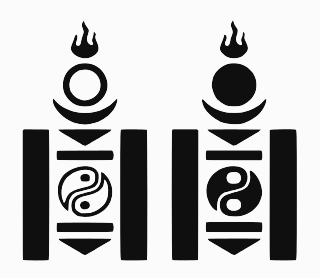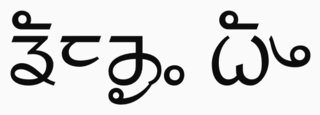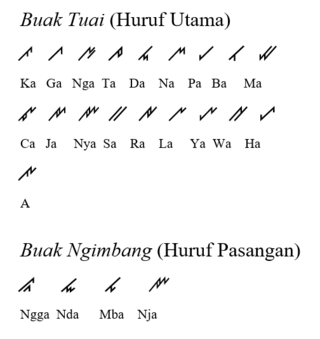
An abugida – sometimes also called alphasyllabary, neosyllabary, or pseudo-alphabet – is a segmental writing system in which consonant–vowel sequences are written as units; each unit is based on a consonant letter, and vowel notation is secondary, similar to a diacritical mark. This contrasts with a full alphabet, in which vowels have status equal to consonants, and with an abjad, in which vowel marking is absent, partial, or optional – in less formal contexts, all three types of the script may be termed "alphabets". The terms also contrast them with a syllabary, in which a single symbol denotes the combination of one consonant and one vowel.

The Kannada script is an abugida of the Brahmic family, used to write Kannada, one of the Dravidian languages of South India especially in the state of Karnataka. It is one of the official scripts of the Indian Republic. Kannada script is also widely used for writing Sanskrit texts in Karnataka. Several minor languages, such as Tulu, Konkani, Kodava, Beary and Sanketi also use alphabets based on the Kannada script. The Kannada and Telugu scripts share very high mutual intellegibility with each other, and are often considered to be regional variants of single script. Other scripts similar to Kannada script are Sinhala script, and Old Peguan script (used in Burma).
The Burmese alphabet is an abugida used for writing Burmese. It is ultimately adapted from a Brahmic script, either the Kadamba or Pallava alphabet of South India. The Burmese alphabet is also used for the liturgical languages of Pali and Sanskrit. In recent decades, other, related alphabets, such as Shan and modern Mon, have been restructured according to the standard of the Burmese alphabet

The Soyombo script is an abugida developed by the monk and scholar Zanabazar in 1686 to write Mongolian. It can also be used to write Tibetan and Sanskrit.
The Batak script is a writing system used to write the Austronesian Batak languages spoken by several million people on the Indonesian island of Sumatra. The script may be derived from the Kawi and Pallava script, ultimately derived from the Brahmi script of India, or from the hypothetical Proto-Sumatran script influenced by Pallava.

The Tamil script is an abugida script that is used by Tamils and Tamil speakers in India, Sri Lanka, Malaysia, Singapore, Indonesia and elsewhere to write the Tamil language. It is one of the official scripts of the Indian Republic. Certain minority languages such as Saurashtra, Badaga, Irula and Paniya are also written in the Tamil script.
Telugu script, an abugida from the Brahmic family of scripts, is used to write the Telugu language, a Dravidian language spoken in the Indian states of Andhra Pradesh and Telangana as well as several other neighbouring states. It is one of the official scripts of the Indian Republic. The Telugu script is also widely used for writing Sanskrit texts and to some extent the Gondi language. It gained prominence during the Eastern Chalukyas also known as Vengi Chalukya era. It shares extensive similarities with the Kannada script, as both of them evolved from the Bhattiprolu and Kadamba scripts of the Brahmi family.

Tagbanwa is one of the scripts indigenous to the Philippines, used by the Tagbanwa and the Palawan people as their ethnic writing system.

The Cham script is a Brahmic abugida used to write Cham, an Austronesian language spoken by some 245,000 Chams in Vietnam and Cambodia. It is written horizontally left to right, just like other Brahmic abugidas.

The Limbu script is used to write the Limbu language. It is a Brahmic type abugida.

Mandombe or Mandombé is a script proposed in 1978 in Mbanza-Ngungu in the Bas-Congo province of the Democratic Republic of the Congo by Wabeladio Payi, who related that it was revealed to him in a dream by Simon Kimbangu, the prophet of the Kimbanguist Church. Mandombe is based on the sacred shapes and , and intended for writing African languages such as Kikongo, as well as the four national languages of the Congo, Kikongo ya leta, Lingala, Tshiluba and Swahili, though it does not have enough vowels to write Lingala fully. It is taught in Kimbanguist church schools in Angola, the Republic of the Congo, and the Democratic Republic of the Congo. It is also promoted by the Kimbanguist Centre de l’Écriture Négro-Africaine (CENA). The Mandombe Academy at CENA is currently working on transcribing other African languages in the script. It has been classified as the third most viable indigenous script of recent indigenous west African scripts, behind only the Vai syllabary and the N'Ko alphabet.
New Tai Lue script, also known as Xishuangbanna Dai and Simplified Tai Lue, is an abugida used to write the Tai Lue language. Developed in China in the 1950s, New Tai Lue is based on the traditional Tai Tham alphabet developed c. 1200. The government of China promoted the alphabet for use as a replacement for the older script; teaching the script was not mandatory, however, and as a result many are illiterate in New Tai Lue. In addition, communities in Burma, Laos, Thailand and Vietnam still use the Tai Tham alphabet.

The Lepcha script, or Róng script, is an abugida used by the Lepcha people to write the Lepcha language. Unusually for an abugida, syllable-final consonants are written as diacritics.

The Rejang script is an abugida of the Brahmic family that is related to other scripts of the region, such as the Batak and Lontara scripts. Rejang is also a member of the closely related group of Ulu scripts that include the script variants of South Sumatra, Bengkulu, Lembak, Lintang, Lebong, and Serawai. Other closely related scripts that are sometimes included in the Surat Ulu group include the Ogan, Kerinci, and Lampung scripts. The script was in use prior to the introduction of Islam to the Rejang area; the earliest attested document appears to date from the mid-18th century CE. The Rejang script is sometimes also known as the KaGaNga script following the first three letters of the alphabet. The term KaGaNga was never used by the users of the script community, but it was coined by the British anthropologist Mervyn A. Jaspan (1926–1975) in his book Folk literature of South Sumatra. Redjang Ka-Ga-Nga texts. Canberra, The Australian National University 1964.

The Saurashtra script is an abugida script that is used by Saurashtrians of Tamil Nadu to write the Saurashtra language. The script is of Brahmic origin, although its exact derivation is not known; it was later reformed and standardized by T. M. Rama Rai. Its usage has declined, and the Tamil and Latin scripts are now used more commonly.

Pahawh Hmong is an indigenous semi-syllabic script, invented in 1959 by Shong Lue Yang, to write two Hmong languages, Hmong Daw (Hmoob Dawb White Miao) and Hmong Njua AKA Hmong Leng (Moob Leeg Green Miao).

Hanunoo, also rendered Hanunó'o, is one of the scripts indigenous to the Philippines and is used by the Mangyan peoples of southern Mindoro to write the Hanunó'o language.

Kulitan, also known as súlat Kapampángan and pamagkulit, is one of the various indigenous suyat writing systems in the Philippines. It was used for writing Kapampangan, a language mainly spoken in Central Luzon, until it was gradually replaced by the Latin alphabet.

Zanabazar's square script is a horizontal Mongolian square script, an abugida developed by the monk and scholar Zanabazar based on the Tibetan alphabet to write Mongolian. It can also be used to write Tibetan language and Sanskrit as a geometric typeface.















